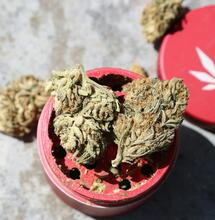The Winter Grow Room

A UK grower shares his experiences with indoor growing during the wintertime.
A UK grower shares his experiences with indoor growing during the wintertime.
|
Control your temps and your plants will repay you! |
A funny thing happened in the UK this year, something that only occurs maybe once every five years or so. This year, we actually had a summer! We have been basking in sunshine for the last few months and enjoying every minute of it. Pub beer gardens have been full. The ladies of the UK have been strutting around wearing next to nothing. It has been awesome!
But, as much as we have enjoyed the novelty of having a suntan and wearing shorts and t-shirts for a few weeks solid, there have been a few downsides - the main one being that indoor growing has been a bit of a nightmare. When the weather gets hot, so do our precious plants. That carefully set up grow room that sits happily at twenty-eight degrees Celcius (just above eighty-two degrees Farenheit) for most of the year and produces plenty of bud time after time, suddenly turns into a sauna. Yield seriously drops and any bud that you do manage to harvest is extremely low in quality.
So, as the weather starts to change and the clouds roll in, we outwardly pretend to our friends that we are upset, when really, we are celebrating on the inside! Finally, we can get a decent crop going again.
A long, hot summer can do funny things to a grower's memory and leave them badly prepared for the cold snap. Try to think back a few months ago and make sure that you have prepped your grow room for a chilly winter.
Firstly, it is important to actually monitor and record the maximum and minimum temperatures that occur in your room. Invest in a min./max. thermo/hygrometer; the easy-to-read digital versions can be bought for around ten bucks.
Monitor your nighttime temperatures, as these can really drop when the cold weather hits. Remember that a big difference in day and night temps can cause your plants to stretch, so try to keep the 'lights-off' temperature within five to six degrees Celcius of the 'lights-on' temperature.
In a smaller grow room, this can be achieved fairly cheaply by investing in an oil-powered radiator and a fan speed controller. The radiator will warm up the room and the speed controller can be used to reduce the fan speed, so that all that nice warm air is not immediately extracted out of the room. You can get a manual controller and just turn it down at night or, even better, get a temperature controller. These enable you to set your minimum and maximum room temperatures and will adjust the fan speed accordingly to maintain it.
|
A fan speed controller will help to maintain your temperatures |
For a larger room, you could heat the space that you pull air in from, so that the air fed into the grow room is already warm. Or, if the grow is big enough to warrant it, install a boiler and a heating system.
The source from which you are ducting your air-in is very important, as cold air hitting the plant will cause the stomata (the pores on the leaves) to close; when this happens, growth will stop. So, where you may have been ducting air into the grow room from outside the house during the warmer summer months, you may wish to duct it in from a warm room in the house during the winter.
If you have no choice and must duct air in from outside, then just increase the length of ducting you use and loop it around a few times inside a warm room. This will help to heat the air up.
If you are growing in the garage or basement, do not put pots directly onto the concrete floor. Concrete is not a great conductor of heat and it will remain cold throughout the day. Cool roots grow slowly, so put the pots onto Styrofoam or a wooden pallet to raise them off the ground - this will also help air circulate around the base of your plants.
If you are using a recirculating hydro system to grow your plants, then you need a submersible water heater in the reservoir to maintain temperature - the kind that you use to heat a fish tank. Set the thermostat to around twenty degrees Celcius (sixty-eight degrees Farenheit) and the roots will stay healthy.
|
Make sure your submersible heater is shatterproof |
Flood-and-drain systems require a shatterproof submersible heater, because when the system floods, the reservoir will empty and heater will be exposed to the air. Some of the better submersible heaters on the market will switch themselves off when removed from the water and automatically turn back on when submerged - clever stuff!
It is also worth remembering that as the temperature drops outside, your indoor grow can become more susceptible to being discovered. Think about where your ducting exits the building: in very cold weather, the warm air being extracted out of your room can become visible as steam. If possible, it may be a better idea to duct it into another internal room for the winter months and avoid detection. Ideally, you should duct it into the chimney.
If you are growing in a loft during the winter, then you must ensure that the loft space has been properly insulated. When the snow comes, you really do not want to be the only house on the street where it does not settle! Use a heavy-duty insulation material, such as King Span, and avoid venting warm air into the loft cavity.
If you are reading this article and have yet to start your winter crop, what are you waiting for? There is still time to get your grow on.
Check out the latest auto-flowering seeds from your favorite seed bank. Almost all of the major companies supply auto versions of their best-selling strains. Yes, in most cases, the yield will be less than the regular seed. But some of the faster varieties can be cultivated from seed to harvest in just sixty to seventy days.
Happy growing!



